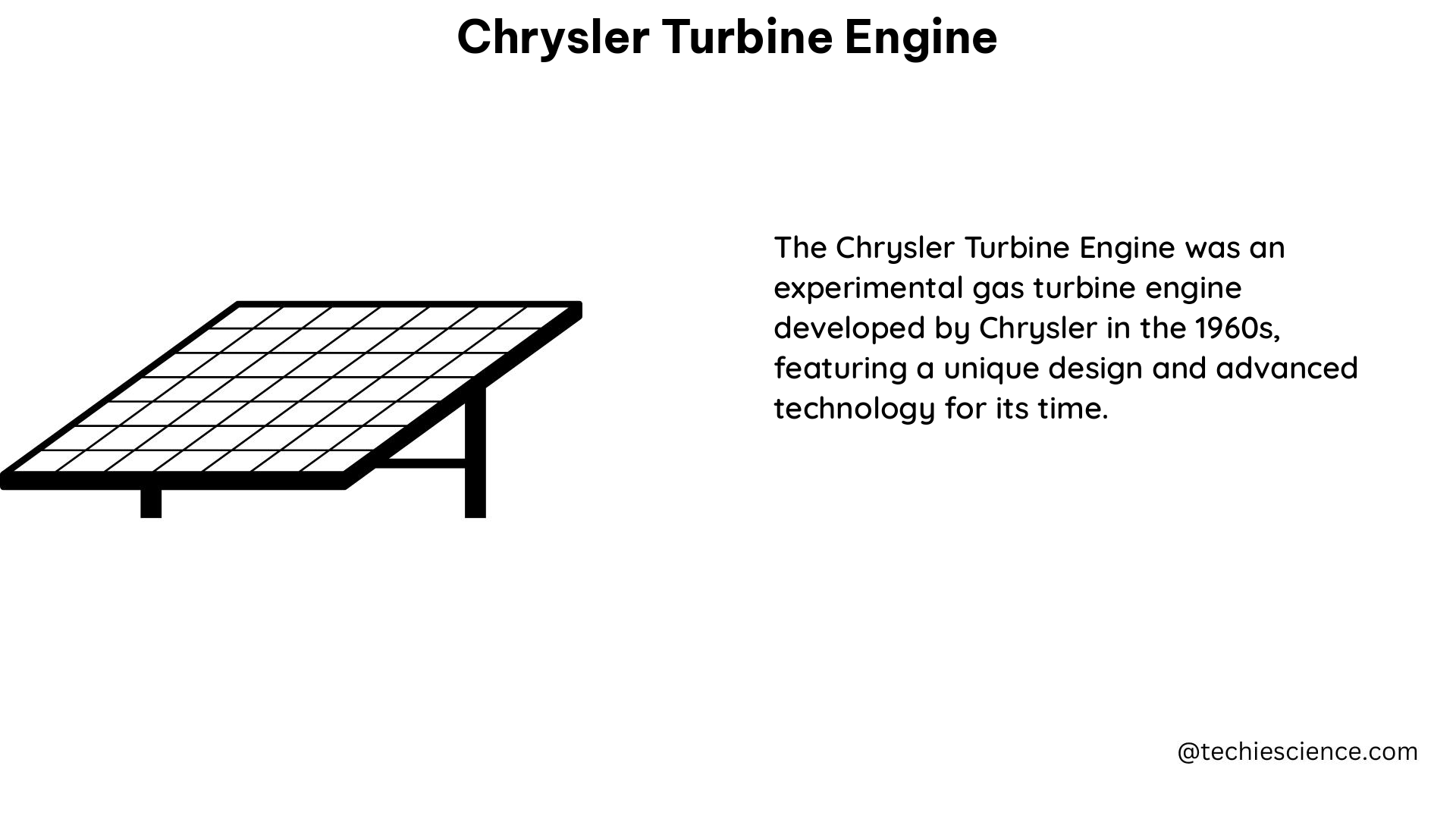The Chrysler turbine engine is a remarkable feat of engineering, a series of gas turbine engines developed by Chrysler for use in road vehicles. Boasting a rich history of innovation, this engine has undergone several generations of development, each iteration pushing the boundaries of fuel efficiency, power, and versatility.
Generations of Chrysler Turbine Engines
-
CR1 (1954): The first successful test of a gas turbine engine in a car took place in 1954 at Chrysler’s testing grounds. This pioneering model, known as the CR1, paved the way for the future advancements of the Chrysler turbine engine.
-
Plymouth Belvedere (1956): In 1956, a turbine-powered Plymouth Belvedere successfully completed a cross-country trip, demonstrating the engine’s capabilities in real-world driving conditions.
-
CR2 (Improved Fuel Economy and Horsepower): The second-generation CR2 engine introduced significant improvements in fuel economy and horsepower, further refining the Chrysler turbine engine’s performance.
-
CR2A (1962 Dodge Dart): The third-generation CR2A engine was installed in a 1962 Dodge Dart, which successfully navigated from New York City to Los Angeles, even in adverse weather conditions.
-
Chrysler Turbine Car (1963): The fourth-generation engine, installed in the iconic Chrysler Turbine Car, represented the pinnacle of Chrysler’s turbine engine development. This remarkable powerplant boasted a host of impressive features.
Chrysler Turbine Car (1963)

The Chrysler Turbine Car’s fourth-generation engine was a true marvel of engineering, showcasing the following remarkable capabilities:
- Revolutions per Minute: The engine could reach up to 44,500 revolutions per minute, a testament to its exceptional performance.
- Fuel Versatility: This engine could operate on a wide range of fuels, including diesel, unleaded gasoline, kerosene, JP-4 jet fuel, and even vegetable oil. In a remarkable demonstration, the engine was even able to run on tequila, as showcased by the then-incumbent President of Mexico.
- Fuel Switching: Switching between different fuel types required no air/fuel adjustments, with the only indication being the odor of the exhaust.
- Vibration-Free Operation: The turbine spins on simple sleeve bearings, ensuring vibration-free running and the potential for long life.
- Maintenance Requirements: The lack of many moving parts and the absence of liquid coolant significantly simplify the engine’s maintenance, with no oil changes considered necessary.
- Exhaust Emissions: The engine’s exhaust does not contain carbon monoxide, uncombusted carbon, or raw hydrocarbons, making it environmentally friendly. However, the challenge of limiting nitrogen oxide emissions remained an ongoing issue throughout the engine’s development.
- Power and Torque: The 1963 Turbine’s engine generated 130 brake horsepower (97 kW; 132 PS) and an impressive 425 pound force-feet (576 N⋅m) of torque at stall speed, enabling a 0 to 60 mph (0 to 97 km/h) acceleration time of 12 seconds at an ambient temperature of 85 °F (29 °C).
- Top Speed: The Chrysler Turbine Car had a top speed of 125 mph (201 km/h), further showcasing the engine’s impressive performance capabilities.
Transmission and Drivetrain
The Chrysler turbine engine’s power turbine is connected, without a torque converter, through a gear reduction unit to a modified TorqueFlite automatic transmission. This unique setup, where the flow of combustion gases between the gas generator and free power turbine provides the same functionality as a torque converter, allows the engine to operate efficiently across a wide range of speeds and loads.
DIY Perspective
While the Chrysler turbine engine is an engineering marvel, its complexity and the ongoing challenge of limiting nitrogen oxide emissions make it a less practical option for most DIY enthusiasts. However, for those with the necessary resources and expertise, exploring the potential of this unique engine design can be a rewarding and educational experience.
Conclusion
The Chrysler turbine engine stands as a testament to the company’s innovative spirit and engineering prowess. From its humble beginnings in 1954 to the impressive fourth-generation engine installed in the Chrysler Turbine Car, this engine has pushed the boundaries of what is possible in the automotive world. While its practical application may be limited, the Chrysler turbine engine remains a fascinating and inspiring example of engineering excellence.
References
- NASA Technical Reports Server. (1982). Experimental Performance of the Regenerator for the Chrysler Upgraded Automotive Gas Turbine Engine. Retrieved from https://ntrs.nasa.gov/api/citations/19820013838/downloads/19820013838.pdf
- EPA. (1974). Chrysler Baseline Gas Turbine Vehicle Tests. Retrieved from https://nepis.epa.gov/Exe/ZyPURL.cgi?Dockey=9100X4DR.TXT
- NASA Technical Reports Server. (1980). Baseline Automotive Gas Turbine Engine Development Program. Retrieved from https://ntrs.nasa.gov/api/citations/19800016127/downloads/19800016127.pdf
- Hagerty Drivers Foundation. (2023). The Chrysler Turbine Car: Engineering a Revolution. Retrieved from https://www.youtube.com/watch?v=fOIrB1fwVPc
- Wikipedia. (2023). Chrysler turbine engines. Retrieved from https://en.wikipedia.org/wiki/Chrysler_turbine_engines

The lambdageeks.com Core SME Team is a group of experienced subject matter experts from diverse scientific and technical fields including Physics, Chemistry, Technology,Electronics & Electrical Engineering, Automotive, Mechanical Engineering. Our team collaborates to create high-quality, well-researched articles on a wide range of science and technology topics for the lambdageeks.com website.
All Our Senior SME are having more than 7 Years of experience in the respective fields . They are either Working Industry Professionals or assocaited With different Universities. Refer Our Authors Page to get to know About our Core SMEs.